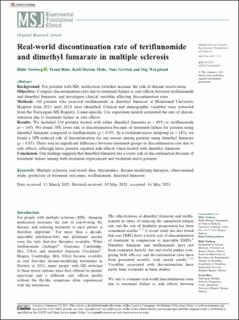Real-world discontinuation rate of teriflunomide and dimethyl fumarate in multiple sclerosis
Journal article, Peer reviewed
Published version

Åpne
Permanent lenke
https://hdl.handle.net/11250/2767667Utgivelsesdato
2021Metadata
Vis full innførselSamlinger
- Department of Clinical Medicine [2066]
- Registrations from Cristin [9791]
Originalversjon
Multiple Sclerosis Journal, Experimental, Translational and Clinical. 2021, 7 (2). 10.1177/20552173211022027Sammendrag
Background
For patients with MS, medication switches increase the risk of disease reactivation.
Objective
Compare discontinuation rates due to treatment failure or side effects between teriflunomide and dimethyl fumarate, and investigate clinical variables affecting discontinuation rates.
Methods
All patients who received teriflunomide or dimethyl fumarate at Haukeland University Hospital from 2013 until 2018 were identified. Clinical and demographic variables were extracted from the Norwegian MS Registry. Cause-specific Cox regression models estimated the rate of discontinuation due to treatment failure or side effects.
Results
We included 354 patients treated with either dimethyl fumarate (n = 185) or teriflunomide (n = 169). We found 38% lower risk of discontinuation because of treatment failure for patients using dimethyl fumarate compared to teriflunomide (p < 0.05). In a treatment-naive subgroup (n = 183), we found a 38% reduced risk of discontinuation for any reason among patients using dimethyl fumarate (p < 0.05). There was no significant difference between treatment groups in discontinuation rate due to side effects, although more patients reported side effects when treated with dimethyl fumarate.
Conclusion
Our findings suggests that dimethyl fumarate has a lower risk of discontinuation because of treatment failure among both treatment-experienced and treatment-naive patients.
